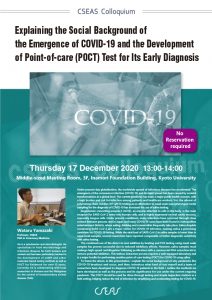Overview:
Under present-day globalization, the worldwide spread of infectious diseases has accelerated. The emergence of the coronavirus infection (COVID-19) and its rapid spread has been caused by societal transformations at a global level. The current pandemic has been a major public health concern, with a high burden and risk for infection among patients and healthcare workers. Yet, the advent of polymerase chain reaction (RT-qPCR) testing as an alternative to nasal swab (nasopharyngeal swab) sampling for the diagnosis of COVID-19 has increased the use of saliva testing.
Angiotensin-converting enzyme II (ACE2), an enzyme attached to cells in the body, is the main receptor for SARS-CoV-2 entry into human cells, and is highly expressed on oral cavity mucosa, especially tongue cells. Under present conditions, many infections have occurred through close contact between persons and in Japan and many COVID-19 cases have been found in metropolitan entertainment districts, where eating, drinking and conversation frequently take place. Saliva droplets containing SARS-CoV-2 are a major vector for COVID-19 infection, making saliva a promising candidate for COVID-19 testing. While the viral load of SARS-CoV-2 in saliva samples is lower than in nasal swab samples, several researchers have reported comparable or better diagnostic sensitivity with saliva testing.
The combined use of the direct-to-test addition by heating and PCR testing using nasal swab samples has proven successful due to reduced inhibitory effects. However, saliva samples must undergo high-speed centrifugation following purification with a commercial RNA extraction kit to remove potential inhibitors. This tedious extraction process requires a well-equipped laboratory and is a major hurdle for performing sensitive point-of-care testing (POCT) for COVID-19 using saliva.
To frame the above, in this presentation, I explain the social background of why pandemics like COVID-19 breakout and occur, and then, introduce what kind of test myself and a team of researchers have developed to diagnose COVID-19 patients in the field. I outline the methods we have developed as well as the process and its significance for use under the current ongoing pandemic. This POCT should be used for drive-through testing and simple inspection stations in a field setting, helping reduce the risk of infection by simplifying and accelerating testing for COVID-19.
Bio:
Wataru Yamazaki holds a PhD in Veterinary Medicine and is a Professor at the Center for Southeast Asian Studies (CSEAS), Kyoto University. He is a veterinarian and microbiologist. He specializes in food microbiology and infectious diseases for both humans and animals and has been particularly involved in the development of LAMP and other molecular-based testing methods as well as POCT for fieldwork for over 15 years. Currently, he is collaborating with local researchers in Vietnam and the Philippines for the control of transboundary animal diseases (TAD).
